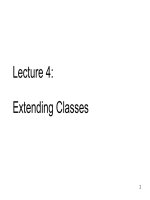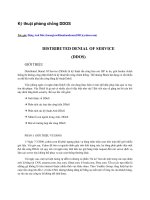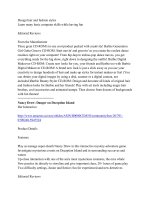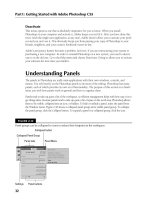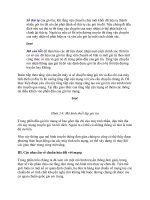CS193P - Lecture 4 ppsx
Bạn đang xem bản rút gọn của tài liệu. Xem và tải ngay bản đầy đủ của tài liệu tại đây (623.44 KB, 40 trang )
CS193P - Lecture 4
iPhone Application Development
Building an Application
Model, View, Controller
Nib Files
Controls and Target-Action
Announcements
•
Assignment 2
■
Due tomorrow
•
Class list:
■
•
WWDC09 Student Scholarship
■
Apply today
■
Due tomorrow!
■
/>Today’s Topics
•
Application Lifecycle
•
Model, View, Controller design
•
Interface Builder and Nib Files
•
Controls and Target-Action
•
HelloPoly demo
Review
Memory Management
•
Alloc/Init
■
-alloc assigns memory; -init sets up the object
■
Override -init, not -alloc
•
Retain/Release
■
Increment and decrement retainCount
■
When retainCount is 0, object is deallocated
■
Don’t call -dealloc!
•
Autorelease
■
*MAGIC*
■
Object is released next time through RunLoop
Setters, Getters, and Properties
•
Setters and Getters have a standard format:
- (int)age;
- (void)setAge:(int)age;
•
Properties allow access to setters and getters through dot
syntax:
@property age;
int theAge = person.age;
person.age = 21;
Building an Application
Anatomy of an Application
•
Compiled code
■
Your code
■
Frameworks
•
Nib files
■
UI elements and other objects
■
Details about object relationships
•
Resources (images, sounds, strings, etc)
•
Info.plist file (application configuration)
App Lifecycle
Launch app
Load main nib
Wait for event
Handle event
Exit app
App initialized
UIKit Framework
•
Provides standard interface elements
•
UIKit and you
■
Don’t fight the frameworks
■
Understand the designs and how you fit into them
UIKit Framework
•
Starts your application
•
Every application has a single instance of UIApplication
■
Singleton design pattern
@interface UIApplication
+ (UIApplication *)sharedApplication
@end
■
Orchestrates the lifecycle of an application
■
Dispatches events
■
Manages status bar, application icon badge
■
Rarely subclassed
■
Uses delegation instead
Delegation
•
Control passed to delegate objects to perform application-
specific behavior
•
Avoids need to subclass complex objects
•
Many UIKit classes use delegates
■
UIApplication
■
UITableView
■
UITextField
•
Xcode project templates have one set up by default
•
Object you provide that participates in application lifecycle
•
Can implement various methods which UIApplication will call
•
Examples:
- (void)applicationDidReceiveMemoryWarning:(UIApplication *)application;
- (void)applicationWillResignActive:(UIApplication *)application;
- (BOOL)application:(UIApplication *)application handleOpenURL:(NSURL *)url;
- (void)applicationDidFinishLaunching:(UIApplication *)application;
- (void)applicationWillTerminate:(UIApplication *)application;
UIApplicationDelegate
Info.plist file
•
Property List (often XML), describing your application
■
Icon appearance
■
Status bar style (default, black, hidden)
■
Orientation
■
Uses Wifi networking
■
System Requirements
•
Can edit most properties in Xcode
■
Project > Edit Active Target “Foo” menu item
■
On the properties tab
Model, View, Controller
If you take nothing else away from this class
Model, View, Controller
Model View
Controller
Model
•
Manages the app data and state
•
Not concerned with UI or presentation
•
Often persists somewhere
•
Same model should be reusable, unchanged in different
interfaces
View
•
Present the Model to the user in an appropriate interface
•
Allows user to manipulate data
•
Does not store any data
■
(except to cache state)
•
Easily reusable & configurable to display different data
Controller
•
Intermediary between Model & View
•
Updates the view when the model changes
•
Updates the model when the user manipulates the view
•
Typically where the app logic lives.
Model, View, Controller
Model View
Controller
outlets
Model, View, Controller
Model Object
Controller
actions
Interface Builder and Nibs
Nib files
Nib Files - Design time
•
Helps you design the ‘V’ in MVC:
■
layout user interface elements
■
add controller objects
■
Connect the controller and UI
Nib Loading
•
At runtime, objects are unarchived
■
Values/settings in Interface Builder are restored
■
Ensures all outlets and actions are connected
■
Order of unarchiving is not defined
•
If loading the nib automatically creates objects and order is
undefined, how do I customize?
■
For example, to displaying initial state

